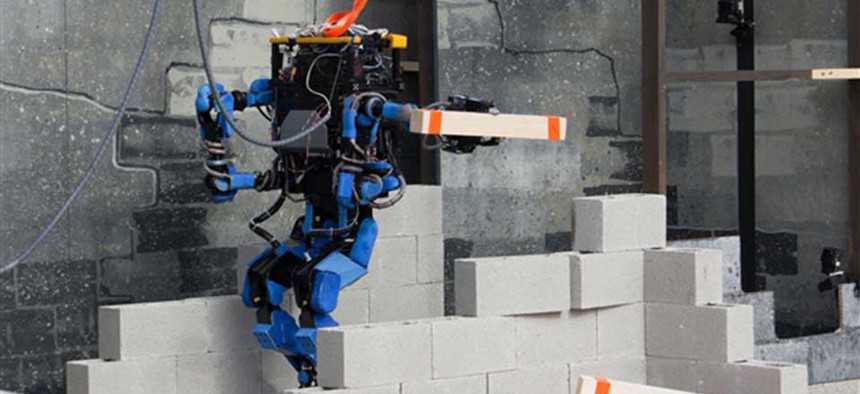
U.S. Defense Department photo/released
3 Things That Have to Happen Before Robot Soldiers Hit the Battlefield
Rumors of Terminator-style soldiers have been greatly exaggerated. By Patrick Tucker
The Defense Advanced Research Projects Agency Robotics Challenge, which is trying to build a walking, climbing, humanoid robot for “disaster relief” operations, has inspired excitement, speculation and anxiety about Terminator-style robots on the future battlefield.
The team currently leading the race is a Tokyo-based group called SCHAFT that was acquired by Google, not long after the Silicon Valley giant acquired Boston Dynamics, creator of the Big Dog robot pack mule and the ATLAS humanoid. So are Google and DARPA ushering the era of Skynet upon us? The short answer is: not anytime soon.
Leading robotics company iRobot isn’t in the competition, but they’ve been in the business of supplying the military with fielded robots for more than 20 years. They’re best known as the maker of the Roomba robot vacuum cleaner, but their most famous defense system, the company’s flagship product, is the PackBot, a tiny tank machine with a long arm. PackBots were originally designed to handle explosive ordnance and one of the machines was featured in the film the Hurt Locker fulfilling that role. Today, they also supply situational awareness to soldiers who need to know what’s around the corner.
When asked if we’ll have humanoid robots wielding machine guns in 15 years, Chris Jones, director of strategic technology for iRobot, laughed and called the question “a hard one to answer.” But he pointed out some visible milestones between where we are now and that destination.
1. Marching Robots Need to Get Smarter
The military’s success with armed, flying drones like the Predator doesn’t necessarily foretell a bright future for gun-toting walking robots. Keeping a machine airborne isn’t as difficult as getting a robot to navigate a 3-D terrestrial environment such as a field cluttered with debris or a bombed-out building, where the chances for mishap are far higher, especially when you introduce live ammunition into the mix. There are also “technical and systems challenges in terms of targeting,” Jones said, for ground robots that have to operate in a more random environment. Those sorts of hurdles don’t exist for airborne drones. “It speaks to an increased bar for robustness and safety,” for ground-roving bots, he said.
(Related: The Future of the Army: Less Soldiers, More Robots, More ‘Lethality’)
These systems will also have to become more independent, requiring much less direct operator-control if they’re to be useful on the battlefield. The bots in the DARPA challenge “are not all that autonomous,” he pointed out. “There’s a [person] in the loop controlling at a lower bandwidth than might have previously been possible but there’s still a [person] directly in the loop.”
Jones pointed to a couple of areas where autonomy is increasing, at least for iRobot products, but not in the area of directly engaging the enemy.
“For example, if there is a situation where communications with the robot are lost as the robot is being driven downrange of its mission, we’ve introduced a user-assist payload that enhances their capability to automatically retro-reverse, reverse their path that they followed downrange, follow it backward until they reach the point at which they re-establish communications with the operator.”
2. The Military Has to Actually Start Talking About Arming Ground Robots
If the Defense Department had been eager to put gun-toting soldier-machines on the streets of Fallujah, it might have made sense to start with some of the robots it already owned. iRobot has already sold more than 5,000 PackBots to the military and has been in business with them for decades, yet Jones said when it comes to the question of arming these machines with AK-47s, “there has been no focused, near-term dialogue on this type of topic.”
Jones is also careful to point out that iRobot isn’t a weapons company. Arming a droid is a bit more complicated a process than just sticking a weapon on a PackBot and kicking the machine into the street. The integration has to be managed and carefully controlled. More collaboration between weapons manufactures and robotics companies could be the key indicator that terminator bots are moving forward.
3. You Will Probably See Humanoid Civilian Robots Before You See Battle Bots
Right now, the biggest player in the DARPA robotics challenge is effectively Google. In addition to owning SCHAFT, six of the top teams in the competition are using ATLAS in their projects. Even though the $2 million prize money isn’t much by Google standards, winning a DARPA challenge would help Google attract talent and interest for future commercial robotics applications and advance the field.
Cost is a key barrier to future deployment of robot infantrymen. If Google was able to put humanoid robots into civilian settings it would probably drive down the costs to build and to operate those sorts of systems. And that would make them more attractive to the military, Jones said.
“Humanoid platforms could have benefits and value at a future date. Their challenges are going to be their cost-effectiveness, their robustness for the field environment and so on,” Jones said. “It’s something that we are certainly paying attention to as that technology matures over the coming years.”
